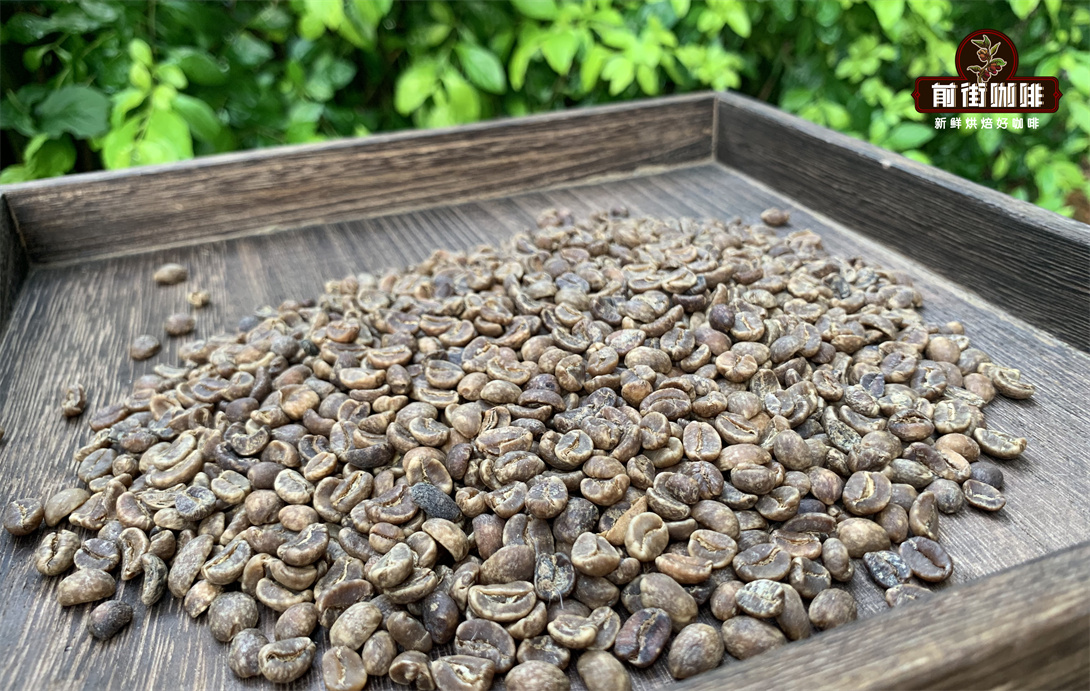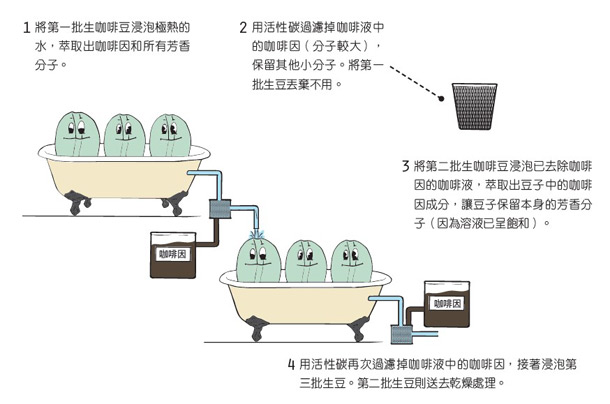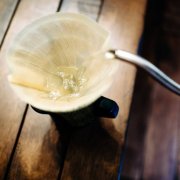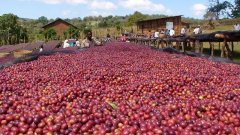Decaf Coffee Bean Story Decaf Coffee Flavor Features Decaf Coffee Advantages and Disadvantages

For professional baristas, please follow the coffee workshop (Wechat official account cafe_style)
Coffee is delicious, but don't drink too much coffee. Coffee contains caffeine. Qianjie Coffee reminds you that proper caffeine can refresh and relieve fatigue. Excessive caffeine can lead to "poisoning". Decaffeinated coffee removes most of the caffeine and retains the flavor of coffee beans. It is suitable for people who like to drink black coffee and are not tolerant to caffeine. As a result, decaf has also appeared on the market to satisfy the taste buds of coffee lovers.

Origin and development of low-caffeine coffee beans
Speaking of decaf, I have to mention the story of Goethe and Langer. As a literary creator, Goethe drinks a lot of coffee every day. But because he can't metabolize caffeine quickly, he often stays up all night. Having no choice but to try, Goethe turned to his good friend Leng, a chemist, in the hope that he could make the coffee less potent.
In 1898, Langer finally lived up to expectations and successfully discovered caffeine in coffee beans, solving the mystery of Goethe's insomnia in drinking coffee. Since the end of the 19th century, scientists have been studying how to inhibit the effect of caffeine in order to remove caffeine and retain other substances in coffee. In 1903, coffee maker Ludwig Roselius commercialized decaffeinated beans for the first time; the technology matured after continuous improvement. However, the decaffeinated process starts with raw coffee beans, and decaffeinated coffee beans are not easy to bake and their aroma is greatly reduced. So how are decaf beans extracted?
Chemical solvent extraction (traditional method)
Caffeine is extracted by chemical solvent, which is divided into direct and indirect methods.

Direct solvent treatment is the use of dichloromethane, ethyl acetate and other chemical solutions to dissolve caffeine. First of all, steam is used to open the stomata of the raw coffee beans, and the dichloromethane solvent is directly added to the coffee beans. After the solvent and caffeine are fused, the caffeine-filled solvents are washed out, and the coffee beans are boiled again to remove all residual solvents.
There are concerns about using dichloromethane as a solvent because it is suspected that long-term exposure increases the risk of cancer. But in fact, FDA limits the dichloromethane content of decaf to 0.001%, which is actually lower than that, with little side effect.
The process of using ethyl acetate as a solvent is the same, ethyl acetate usually comes from sugar cane, so when used, the direct solvent method is sometimes referred to as sugarcane decontamination. This method is usually used in de-causation in Colombia. But ethyl acetate is a highly flammable substance, so it is more dangerous.

Coffee beans do not come into direct contact with solvents. But now it has generally stopped using this method for deconstruction.
Swiss Water treatment method (SWP)

This method was invented in 1933 without the use of chemical solvents and was commercialized in the 1980s under the registered trademark The Swiss Water ®Process. This treatment will soak the raw coffee beans in hot water, and the soaking stage has actually partially removed caffeine. The soaked solution is then filtered with activated carbon and finally poured back into the coffee beans. This series of steps will be more effective in removing caffeine. In addition to not requiring the use of chemical solvents, the soaked solution can be reused in different batches of treatment procedures, but the coffee will still lose flavor during the filtration process.
The caffeine removal rate of this method can reach 99.9%, which is also the highest method of caffeine removal.
Mountain spring water treatment
Similar to Swiss water treatment, another special kind of water is used to extract caffeine from glaciers. The company Descamex says it uses a special filter to remove caffeine. After treatment, you will get a caffeine-free aqueous solution, which also dissolves the solid substance of coffee and can be reused in the decaffeinated process.
Supercritical carbon dioxide treatment

This treatment is to first let the coffee beans absorb water and expand, and the caffeine molecules are loose in the coffee beans. Add liquefied carbon dioxide and create more than 100 atmospheric pressure in water. Carbon dioxide is highly selective and does not "damage" the carbohydrates and proteins in coffee beans while dissolving caffeine, ensuring that the flavor of coffee beans is not destroyed. Liquid carbon dioxide that takes away caffeine can also be removed and recycled.
Coffee made from decaffeinated carbon dioxide has a lower burden on the human body, and according to the study, this method extracts more coffee than the direct solvent method, and the cost of this method is much higher than that of the direct solvent method.

Advantages and disadvantages of decaf coffee
Caffeine is actually the largest source of antioxidants in Western diets; decaf coffee usually contains antioxidants in similar amounts to regular coffee, but they can be as low as 15%. This difference is probably due to a small loss of antioxidants in the decaffeinated process. So now more and more people choose decaf coffee because it not only has the effect of antioxidation, but also does not affect sleep.
The main antioxidants in regular and decaffeinated coffee are hydrogenated cinnamic acid and polyphenols. Antioxidants are very effective in neutralizing active compounds called free radicals. This can reduce oxidative damage and may help prevent diseases such as heart disease, cancer and type 2 diabetes.
In addition to antioxidants, decaffeinated coffee also contains small amounts of nutrients. A cup of decaffeinated coffee provides 2.4% of the recommended daily intake of magnesium, 4.8% of potassium and 2.5% of niacin, or vitamin B3. This may not seem like a lot of nutrients, but if you drink 2-3 cups (or more) of coffee a day, these amounts will increase quickly.
Combined with the above decaf treatment, Qianjie Coffee believes that the bad taste of decaf coffee is not caused by the treatment. Because most decaf coffee in the raw materials to choose some cheap, commercial grade coffee beans. Modern decaffeinated technology is quite complex, and in most cases, companies that produce decaffeinated coffee will naturally prefer some varieties of coffee beans with high caffeine content (such as robusta beans) when choosing raw materials. Coffee beans have been untasty before decaffeinated beans. Like other coffee beans sold in coffee shops, low-caffeinated coffee can perform very well even after decaffeination if it starts with high-quality Arabica beans from the beginning of raw beans.
Speaking of so many low-caffeine coffee treatments, there is a low-caffeine bean from Huilan in front of the street, and the treatment method used is the Swiss water treatment, which can remove 99.9% of the caffeine. It is also the method with the highest caffeine removal rate.

The color of raw coffee beans after decontamination will be dark green.

After the roasted beans have been placed for a few days, the beans will be more oily and shiny. The reason may be that in the process of decaffeination, coffee beans need to be soaked in hot water to release caffeine, and then dried. In this process, the fiber structure of coffee may have changed, resulting in the release of oil more easily when roasting reaches medium to deep baking.

Cooking suggestion
Important Notice :
前街咖啡 FrontStreet Coffee has moved to new addredd:
FrontStreet Coffee Address: 315,Donghua East Road,GuangZhou
Tel:020 38364473
- Prev

Coffee bean flavor classification table bitter, sour, sweet, neutral, mellow coffee beans
For professional baristas, please pay attention to the taste classification of coffee beans in the coffee workshop (Wechat official account cafe_style): sour taste: mocha, Hawaiian sour coffee, Mexico, Guatemala, Costa Rica high real estate, Guilimanjaro, Colombia, Zimbabwe, El Salvador, Western Hemisphere washing advanced new bean bitterness: Java, Manning, Bogot á, Angola,
- Next

What is coffee manor? what are the characteristics of coffee beans
Definition: coffee beans produced by a single coffee farm or a cooperative made up of several coffee farmers. Features: coffee beans can maintain a certain level of quality, not only that, coffee beans from different estates have different flavors, but also reflect local characteristics to a certain extent. Packaging description: in order to highlight the characteristics of their own manor, so the description of manor beans is more detailed. On the package
Related
- Beginners will see the "Coffee pull flower" guide!
- What is the difference between ice blog purified milk and ordinary milk coffee?
- Why is the Philippines the largest producer of crops in Liberia?
- For coffee extraction, should the fine powder be retained?
- How does extracted espresso fill pressed powder? How much strength does it take to press the powder?
- How to make jasmine cold extract coffee? Is the jasmine + latte good?
- Will this little toy really make the coffee taste better? How does Lily Drip affect coffee extraction?
- Will the action of slapping the filter cup also affect coffee extraction?
- What's the difference between powder-to-water ratio and powder-to-liquid ratio?
- What is the Ethiopian local species? What does it have to do with Heirloom native species?

